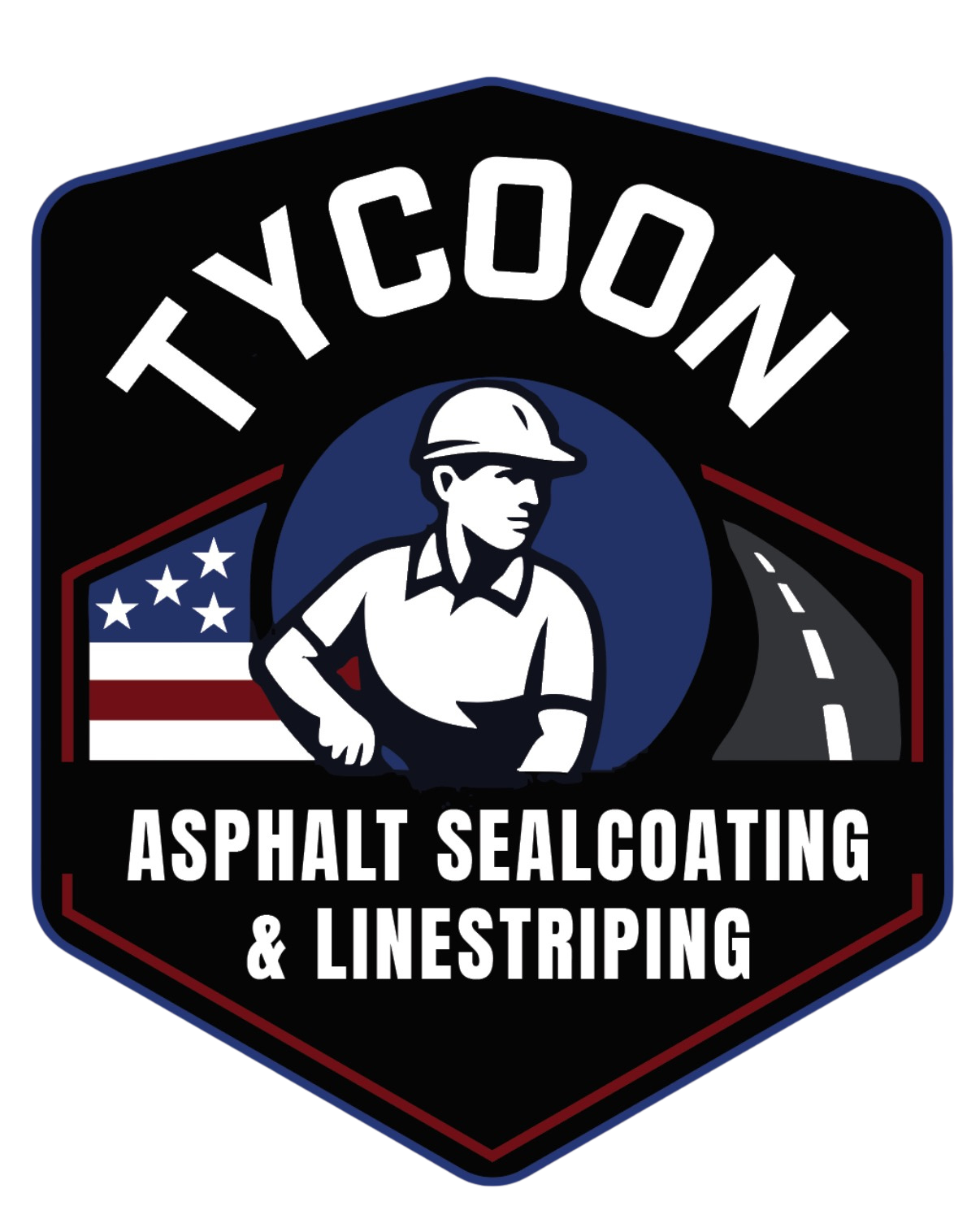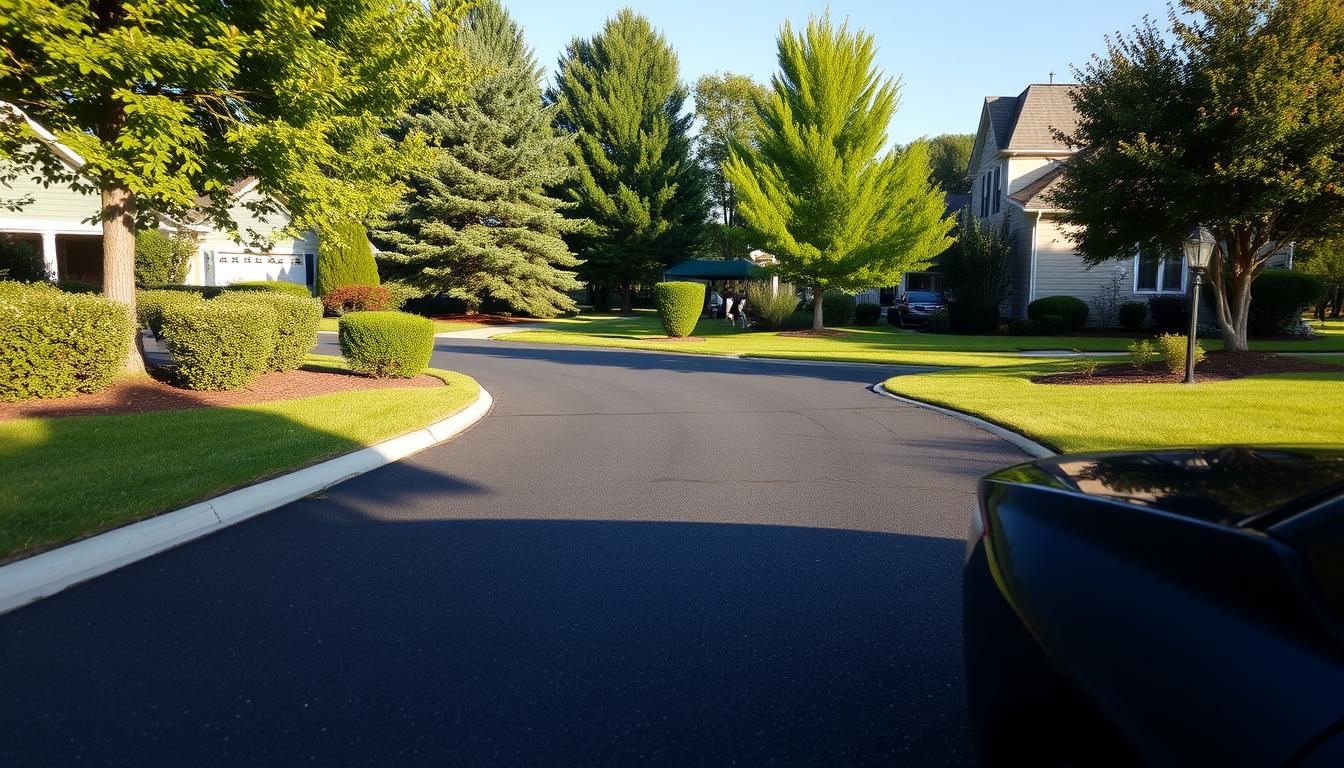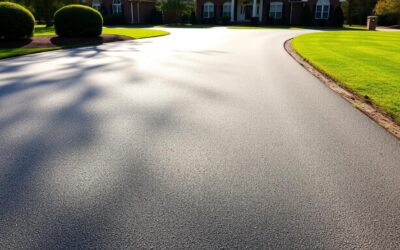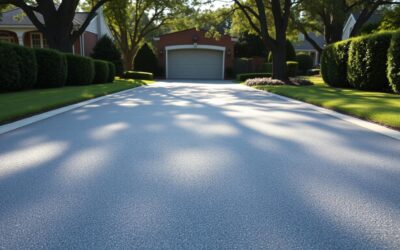We help homeowners and small businesses set a simple, practical maintenance schedule for asphalt that protects curb and extends service life. New paving should get its first coating within six to twelve months. For most residential driveways we recommend a two to three year rotation, while parking lots with heavy traffic benefit from a one to two year plan.
Our sealcoating services use a thin, even layer that cures in 24 to 48 hours. That short downtime gives immediate curb appeal and long-term protection against UV, moisture, oil, and chemicals. Regular care slows oxidation, limits water penetration, and avoids costly repairs.
We start with a quick assessment and create a tailored schedule for your property and traffic patterns. Expect clear timing, reminders, and minimal disruption so you see results now and value over time.
What Sealcoating Does for Your Asphalt Surface
An even coating creates a shield that keeps pavement sound and looking sharp longer. We apply a thin, measured layer that deflects UV rays, resists water intrusion, and repels oil and other automotive fluids. This simple process preserves the binder and slows oxidation.
A protective layer against UV rays, water, and oil
We lay down a protective layer that keeps sunlight from drying the binder and making the surface brittle. The barrier also reduces water penetration so freeze-thaw cycles and heavy storms don’t accelerate base damage.
By repelling oil and chemicals, the coating helps prevent soft spots and raveling. That keeps driving lanes smooth and reduces the chance of rutting in high-use areas.
How sealcoating prevents oxidation and costly repairs
With less oxygen contact, oxidation slows and hairline cracks are far less likely to widen into bigger failures. Limiting micro-abrasion from tires lowers fine wear in turning and braking zones.
We use calibrated equipment to apply a uniform layer that improves appearance and extends service life. For more on practical advantages, read the benefits of sealcoating.
How Often Sealcoat North Carolina: Our Recommended Schedule
We set clear, realistic timelines so your pavement stays strong and looks great year after year. Our plan adapts to the type of surface, usage, and local factors to get the best results with minimal disruption.
Residential driveways: every 2-3 years for lasting curb appeal
For most homes we recommend a sealcoating interval of 2 to 3 years. This keeps color uniform and slows oxidation without over-coating the surface.
New asphalt: first coat at 6-12 months after paving
New asphalt should receive its first coat at six to twelve months. That timing protects the binder once initial curing finishes and avoids trapping volatiles under the layer.
Parking lots and high-traffic areas: every 1-2 years
Commercial parking lots and high-use zones see more vehicles and fluid exposure. We typically schedule sealcoating every 1 to 2 years. Entrances and heavy-turn areas may need annual work to prevent costly repairs.
Each visit uses a controlled coat thickness to prevent tracking and ensure even curing. We factor shade, drainage, and turning movements into the maintenance schedule and send reminders so your lot or driveway stays on track.
North Carolina Weather Conditions and Their Impact on Sealcoating Time
Timing sealcoating around local weather gives the best results. We choose days when temperature and humidity favor curing. That lowers the chance of defects and improves long-term performance.
Sun exposure and heat across the Piedmont and Coastal Plain
In sunny areas, strong UV rays speed oxidation and increase surface wear. We apply protection earlier in the season to slow color loss and binder breakdown.
Moisture, storms, and water intrusion risks
High humidity and heavy storms can trap moisture in the pavement or dilute material during application. We watch forecasts closely and avoid rain windows to protect finish quality.
Mountain freeze-thaw cycles and seasonal swings
Mountain areas face more freeze-thaw cycles that widen small cracks. We time work to seal micro-failures before water expands and causes bigger damage.
We also plan around parking and traffic peaks so cure time is not compromised. Choosing the right conditions helps the coating form a tight film that resists rays and rain.
Key Factors That Affect Your Sealcoating Schedule
Several key factors shape a practical maintenance plan for asphalt surfaces. We review use, material, and site conditions to set a schedule that balances cost and protection.
Traffic volume and vehicle types
We evaluate traffic and the kinds of vehicles that use your surface. Heavy trucks, frequent braking, and tight turning increase wear and shorten the interval between coats.
Existing pavement condition
Fading, new cracks, and raveling are early warning signs. When those issues appear, we tighten the schedule to stop water entry and prevent base failure.
Sealant quality and number of coats
The sealant you choose affects longevity. Higher-quality formulations and properly layered coats give longer protection and can extend time between visits.
Maintenance habits and site conditions
Regular cleaning, prompt crack repairs, and oil spot removal boost film life. Shade, poor drainage, and ponding also change our timing and application approach.
We combine these factors into a custom plan that protects appearance and reduces repair risk without wasting resources.
The Benefits You’ll See from Regular Asphalt Sealcoating
Regular coatings give your pavement protection that pays off in fewer repairs and a cleaner curb presence. We apply work that slows wear and produces visible, immediate improvement.
Extended lifespan and protection from premature wear
We block UV rays and oxygen that cause cracking and loss of binder. That extends pavement lifespan and delays costly rehabilitation.
Improved appearance and fresh, uniform color
A fresh film restores the deep black tone and boosts curb appeal. Good appearance helps homes and storefronts look cared for year round.
Defense against oil, chemicals, and vehicle leaks
The coating resists oil and water intrusion so drips and spills do less harm. You’ll see practical results in fewer patch jobs and better performance in high-use areas.
With routine maintenance, sealcoating delivers clear benefits and longer life for your surface. We tailor work to your site so the results balance cost, protection, and lasting appeal.
Our Asphalt Sealcoating Process for Reliable Results
Our crew follows a step-by-step process that prepares pavement, fixes small failures, and delivers a uniform finish that lasts.
Surface prep: cleaning, edge work, and crack repairs
We begin with meticulous cleaning. Sweeping and power washing remove dirt and loose material so the sealant bonds to the asphalt surface.
Next, our team routes and fills cracks and performs small repairs. Fixing these issues first prevents the coating from masking problems that need repair.
Applying a thin, even coat for optimal performance
We apply a controlled layer using calibrated sprayers and squeegees. A thin, even film prevents peeling and gives consistent results across the paving.
Using high-quality sealant matched to your conditions
Product choice matters. We match a high-quality sealant to site conditions and climate so the finish meets expectations for durability and appearance.
Curing times and traffic control for a durable finish
We manage access while the coat cures. Typical curing is 24–48 hours depending on temperature and humidity.
Before we reopen the pavement, we perform quality checks at edges, drains, and high-wear zones to confirm coverage and final results.
Best Time of Year to Sealcoat in North Carolina
Timing matters for good results. We recommend scheduling sealcoating during warm, dry weather so the material forms a continuous film and the texture cures evenly.
Why warm, dry weather delivers the best results
Warm daytime temps and moderate humidity speed drying and promote adhesion. That reduces the chance of streaking or soft spots after the coat sets.
If mornings are cool, we shift start times so the pavement is dry and warm. This improves bonding and helps the coating reach full strength within 24–48 hours.
Scheduling around rain events and humidity
We choose late spring through early fall as primary windows because rain chances drop and weather conditions are more predictable. That gives flexible schedule options across most years.
Our team watches hourly forecasts and sets access limits during cure. We also bundle maintenance tasks like crack filling into the same visit to save time and reduce closures.
Driveways vs. Parking Lots: Different Needs, Different Schedules
Not all pavement sees the same use, so we tailor maintenance to match wear. Light residential traffic needs less frequent attention than commercial zones with constant vehicle movement.
For most homes, driveways take light loads and do well with a 2–3 year sealcoating cycle. That schedule keeps color and binder protection without needless expense.
Commercial parking areas, by contrast, face heavy traffic, turning, and oil exposure. A busy parking lot usually benefits from a 1–2 year interval to limit surface breakdown and stains.
We spray large parking zones for fast, even coverage and squeegee edges for a neat border. After curing, refreshed striping restores visibility for ADA paths, stop bars, and directional arrows.
At mixed-use sites we stage work in sections so critical lanes stay open while nearby bays cure. Our services focus protection where vehicles spend the most time — entrances, aisles, and loading edges — so the whole site lasts longer.
Coordinating coating and line work improves safety and performance across all areas of your asphalt surface.
Signs It’s Time to Recoat Your Asphalt
Small changes in color and texture are the clearest cues that a recoat is due. Below we list the visible indicators we check during an inspection and explain why prompt action protects your pavement.
Color fading, fine surface wear, and new hairline cracks
If the black has dulled to gray, that appearance change often signals the protective film has thinned. Fine surface wear and hairline cracks let in moisture and oxygen, which leads to larger issues over time.
When it has been a few years since the last coat, we measure film thickness and recommend the next step. Stains from oil or chemicals that won’t lift with cleaning also mean the coating needs renewal.
We always prepare the pavement before applying asphalt sealcoating. That includes thorough cleaning and minor repairs so the new coat bonds and cures evenly. Timing the work for warm, dry weather reduces scuffing and improves finish quality.
Our inspection notes explain what we see and why we suggest recoating now versus waiting. Acting on early signs saves you money on major repairs later and keeps your surface looking its best.
Ready for a Longer-Lasting, Better-Looking Surface? Let’s Get to Work
Ready to protect your pavement and cut long-term maintenance costs with a single plan?
We offer tailored services that bundle sealant selection, paving touch-ups, and striping so your property stays safe and looks great. Our team schedules work to maximize protection and extend lifespan while preventing issues before they grow into costly repairs.
For parking lots and driveways we phase work to limit disruption, return for crisp striping, and manage cure times. Our crew uses proven products and quality methods to stand up to traffic, oil, and weather.
Ask us for an on-site assessment and a simple plan that keeps your asphalt looking sharp season after season.




0 Comments